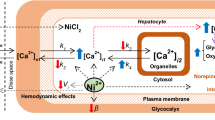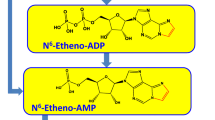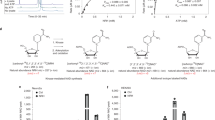Abstract
The perfused rat liver responds in several ways to NAD+ infusion (20–100 μM). Increases in portal perfusion pressure and glycogenolysis and transient inhibition of oxygen consumption and gluconeogenesis are some of the effects that were observed. Extracellular NAD+ is also extensively transformed in the liver. The purpose of the present work was to determine the main products of extracellular NAD+ transformation under various conditions and to investigate the possible contribution of these products for the metabolic effects of the parent compound. The experiments were done with the isolated perfused rat liver. The NAD+ transformation was monitored by HPLC. Confirming previous findings, the single-pass transformation of 100 μM NAD+ ranged between 75% at 1.5 min after starting infusion to 95% at 8 min. The most important products of single-pass NAD+ transformation appearing in the outflowing perfusate were nicotinamide, ADP-ribose, uric acid, and inosine. The relative proportions of these products presented some variations with the time after initiation of NAD+ infusion and the perfusion conditions, but ADP-ribose was always more abundant than uric acid and inosine. Cyclic ADP-ribose (cADP-ribose) as well as adenosine were not detected in the outflowing perfusate. The metabolic effects of ADP-ribose were essentially those already described for NAD+. These effects were sensitive to suramin (P2XY purinergic receptor antagonist) and insensitive to 3,7-dimethyl-1-(2-propargyl)-xanthine (A2 purinergic receptor antagonist). Inosine, a known purinergic A3 agonist, was also active on metabolism, but uric acid and nicotinamide were inactive. It was concluded that the metabolic and hemodynamic effects of extracellular NAD+ are caused mainly by interactions with purinergic receptors with a highly significant participation of its main transformation product ADP-ribose.








Similar content being viewed by others
References
Clapper DL, Walseth TF, Dargie PJ, Lee HC (1987) Pyridine nucleotide metabolites stimulate calcium release from sea urchin egg microsomes desensitized to inositol trisphosphate. J Biol Chem 262:9561–9568
Lee HC, Walseth TF, Bratt GT, Haynes RN, Clapper DL (1989) Structural determination of a cyclic metabolite of NAD+ with intracellular Ca2+-mobilizing activity. J Biol Chem 264:1608–1615
Lee HC (1994) Cyclic ADP-ribose: a calcium mobilizing metabolite of NAD+. Mol Cell Biochem 138:229–235
Koshiyama H, Lee HC, Tashjian AH (1991) Novel mechanism of intracellular calcium release in pituitary cells. J Biol Chem 266:16985–16988
Ziegler M (2000) New functions of a long-known molecule. Emerging roles of NAD in cellular signaling. Eur J Biochem 267:1550–1564
Bruzzone S, Guida L, Zocchi E, Franco L, De Flora A (2000) Connexin 43 hemi-channels mediate Ca2+-regulated transmembrane NAD+ fluxes in intact cells. FASEB J 15:10–12
Bruzzone S, Franco L, Guida L, Zocchi E, Contini P, Bisso A, Usai C, De Flora A (2001) A self-restricted CD38-connexin 43 cross-talk affects NAD+ and cyclic ADP-ribose metabolism and regulates intracellular calcium in 3T3 fibroblasts. J Biol Chem 276:48300–48308
Franco F, Zocchi E, Usai C, Guida L, Bruzzone S, Costa A, De Flora A (2001) Paracrine roles of NAD+ and cyclic ADP-ribose in increasing intracellular calcium and enhancing cell proliferation of 3T3 fibroblasts. J Biol Chem 276:21642–21648
Berthoud VM, Iwanij V, Garcia AM, Saez JC (1992) Connexins and glucagon receptors during development of rat hepatic acinus. Am J Physiol 263:G650–G658
Greenwel P, Rubin J, Schwartz M, Hertzberg EL, Rojkind M (1993) Liver fat-storing cell clones obtained from a CC14-cirrhotic rat are heterogeneous with regard to proliferation, expression of extracellular matrix components, interleukin-6 and connexin 43. Lab Investig 69:210–216
Ma XD, Sui YF, Wang WL (1997) Expression of gap junction genes connexin 32, connexin 43 and their proteins in hepatocellular carcinoma and normal liver tissues. World J Gastroenterol 6:66–69
Ohlrogge W, Haag F, Löhler J, Seman M, Littman DR, Killeen N, Koch-Nolte F (2002) Generation and characterization of ecto-ADP-ribosyltransferase ART2.1/ART2.2-Deficient Mice. Mol Cell Biol 22:7535–7542
Broetto-Biazon AC, Bracht A, Ishii-Iwamoto EL, Silva VM, Kelmer-Bracht AM (2004) The action of extracellular NAD+ on Ca2+ efflux, hemodynamics and some metabolic parameters in the isolated perfused rat liver. Eur J Pharmacol 484:291–301
Gimenes D, Constantin J, Comar JF, Kelmer-Bracht AM, Broetto-Biazon AC, Bracht A (2006) Liver parenchyma heterogeneity in the response to extracellular NAD+. Cell Biochem Funct 24:313–325
Martins AG, Constantin J, Bracht F, Kelmer-Bracht AM, Bracht A (2006) The action of extracellular NAD+ on gluconeogenesis in the perfused rat liver. Mol Cell Biochem 286:115–124
Liersch M, Grotelüschen H, Decker K (1971) NAD permeation into the liver cell. Hoppe-Seyler’s Z Physiol Chem 352:267–274
Scholz R, Bücher T (1965) Hemoglobin-free perfusion of rat liver. In: Chance B, Estabrook RW, Williamson JR (eds) Control of energy metabolism. Academic Press, New York, pp 393–414
Reinhart PH, Taylor WM, Bygrave FL (1982) Calcium ion fluxes induced by the action of alpha-adrenergic agonists in perfused rat liver. Biochem J 208:619–630
Bergmeyer HU, Bernt E (1974) Determination of glucose with glucose oxidase and peroxidase. In: Bergmeyer HU (ed) Methods of enzymatic analysis. Verlag Chemie/Academic Press, Weinheim/London, pp 1205–1215
Gutman J, Wahlefeld AW (1974) l-(+)-Lactate determination with lactate dehydrogenase and NAD+. In: Bergmeyer HU (ed) Methods of enzymatic analysis. Verlag Chemie/Academic Press, Weinheim/London, pp 1464–1468
Czok R, Lamprecht W (1974) Pyruvate, phosphoenolpyruvate and d-glycerate-2-phosphate. In: Bergmeyer HU (ed) Methods of enzymatic analysis. Verlag Chemie/Academic Press, Weinheim/London, pp 1446–1451
Volwerk JJ, Pieterson WA, de Haas GH (1974) Histidine at the active site of phospholipase A2. Biochemistry 13:1446–1454
Dubyak GR, El-Moatassim C (1993) Signal transduction via P2-purinergic receptors for extracellular ATP and other nucleotides. Am J Physiol 265:C577–C606
Ukena D, Shamim MT, Padgett W, Daly JW (1986) Analogs of caffeine: antagonists with selectivity for A2 adenosine receptors. Life Sci 39:743–750
Schuetz A, Min J, Antoschenko T, Wang CH, Alleli-Hassani A, Dong A, Loppnau P, Vedadi M, Bochkarev A, Stemglanz R, Plotnikov AN (2007) Structural basis of inhibition of h ehuman NAD+-dependent deacetylase SIRT5 by suramin. Structure 15:377–389
Guinzberg R, Cortés D, Díaz-Cruz A, Riveros-Rosas H, Villalobos-Molina R, Piña E (2006) Inosine released after hypoxia activates hepatic glucose liberation through A3 adenosine receptors. Am J Physiol Endocrinol Metab 290:E940–E951
Schuber F, Travo P, Pascal M (1976) Calf-spleen nicotinamide-adenine dinu-cleotide glycohydrolase kinetic mechanism. Eur J Biochem 69:593–602
Moreschi I, Bruzzone S, Nicholas RA, Fruscione F, Sturla L, Benvenuto F, Usai C, Meis S, Kassack MU, Zocchi E, De Flora A (2006) Extracellular NAD+ is an agonist of the human P2Y11 purinergic receptor in human granulocytes. J Biol Chem 42:31419–31429
Fernandes TRL, Suzuki-Kemmelmeier F, Constantin J, Ishii-Iwamoto EL, Bracht A (1999) Regional heterogeneities in the production of uric acid from adenosine in the bivascularly perfused rat liver. Mol Cell Biochem 195:207–217
Aksoy P, White TA, Thompson M, Chini EN (2006) Regulation of intracellular levels of NAD: a novel role for CD38. Biochem Biophys Res Commun 345:1386–1392
Amar-Costesec A, Prado-Figueroa M, Beaufay H, Nagelkerke JF, van Berkel TJ (1985) Analytical study of microsomes and isolated subcellular membranes from rat liver: IX. Nicotinamide adenine dinucleotide glycohydrolase: a plasma membrane enzyme prominently found in Kupffer cells. J Cell Biol 100:89–97
Minguetti-Câmara VC, Constantin J, Suzuki-Kemmelmeier F, Ishii-Iwamoto EL, Bracht A (1998) Hepatic heterogeneity in the response to ATP studied in the bivascularly perfused rat liver. Mol Cell Biochem 179:35–48
Derbocio AM, Kelmer-Bracht AM, Bracht L, Bracht A, Ishii-Iwamoto EL (2005) The hemodynamic effects of zymosann the perfused rat liver. Vasc Pharmacol 43:75–85
Zocchi E, Franco L, Guida L, Piccini D, Tacchetti C, De Flora A (1996) NAD+-dependent internalization of the transmembrane glycoprotein CD38 in human Namalwa B cells. FEBS Lett 396:327–332
Liang M, Chini EN, Cheng J, Dousa TP (1999) Synthesis of NAADP and cADPR in mitochondria. Arch Biochem Biophys 371:317–325
Chagoya de Sánchez V (1995) Circadian variations of adenosine and of its metabolism. Could adenosine be a molecular oscillator for circadian rhythms? Can J Physiol Pharmacol 73:339–355
Fernandes TRL, Suzuki-Kemmelmeier F, Prado EC, Bracht A (1999) The metabolic response of the bivascularly perfused rat liver to adenosine. Biochem Pharmacol 58:397–409
Acknowledgments
This work was supported by grants from the Conselho Nacional de Desenvolvimento Científicoe Tecnológico (CNPq).
Author information
Authors and Affiliations
Corresponding author
Rights and permissions
About this article
Cite this article
Broetto-Biazon, A.C., Bracht, F., de Sá-Nakanishi, A.B. et al. Transformation products of extracellular NAD+ in the rat liver: kinetics of formation and metabolic action . Mol Cell Biochem 307, 41–50 (2008). https://doi.org/10.1007/s11010-007-9582-7
Received:
Accepted:
Published:
Issue Date:
DOI: https://doi.org/10.1007/s11010-007-9582-7




